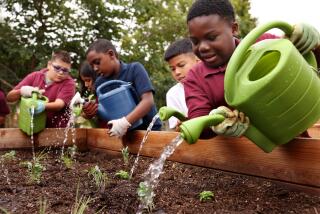Students Get Close-Up Look at Wildlife Area
- Share via
It was the first time that Pablo Morales had used binoculars. After slipping the strap over his head, the Noble Avenue School fourth-grader pointed them toward the cloudless sky as a red-tailed hawk circled overhead.
“Wow, binoculars are baaad,” Pablo said. “Birds look nice when they are flying.”
Pablo was one of about 60 children from the North Hills elementary school to visit the Sepulveda Basin Wildlife Area on Thursday as part of an education program called “Water, Wetlands and Wildlife.”
The program was developed last year with a portion of a $98,000 fine levied by a state water panel against Anheuser-Busch Cos. as compensation for two chemical spills from the company’s Van Nuys brewery into a stream that flows through the area.
A consortium of environmental organizations led by the National Audubon Society and Los Angeles’ Clean Water Program devised the curriculum with about $25,000. More than a dozen San Fernando Valley elementary schools will visit the basin this semester as part of the wetlands-education program, which includes classroom study and staff-development workshops for the teachers.
Irene Budworth, one of the Noble teachers participating in the program, said that besides educating children about the fragile wetlands, the field trip was a welcome break from the classroom.
“These kids really need this,” Budworth said. “A lot of them have never been anywhere like this before.”
In a wildlife oasis just minutes from the busy San Diego Freeway, environmentalists answered questions and pointed out different species of animals. The children took turns reading the pH-balance and temperature of water samples. They looked through microscopes at plankton thriving in the ponds.
As gusty breezes rippled across ponds, the children peered through binoculars to see a skinny great egret standing at the water’s edge and a flock of white pelicans gracefully flapping their wings in near-perfect formation.
“Birds were here a long time ago,” said Juan Fuentes, a sixth-grader. “The world would be boring without them.”
It was exactly the reaction that Leo French, a naturalist from the Topanga-Las Virgenes Resource Conservation District who conducted the field trip, wanted the students to have.
“I hope it instills a little bit of stewardship for our planet,” French said. “These are our future caretakers. The more they know and appreciate, the better.”
More to Read
Sign up for Essential California
The most important California stories and recommendations in your inbox every morning.
You may occasionally receive promotional content from the Los Angeles Times.










